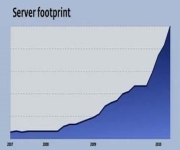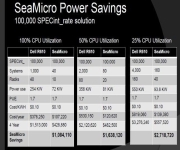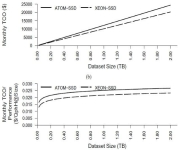Author Archive

Hierarchical storage management (HSM) also called tiered storage management is back but in a different form. HSM exploits the access pattern skew across data sets by placing cold, seldom accessed data on slow cheap media and frequently accessed data on fast near media. In old days, HSM typically referred to system mixing robotically managed tape…
I didn’t attend the Hadoop Summit this year or last but was at the inaugural event back in 2008 and it was excellent. This year, the Hadoop Summit 2010 was held June 29 again in Santa Clara. This agenda for the 2010 event is at: Hadoop Summit 2010 Agenda. Since I wasn’t able to be…
I did a talk at Velocity 2010 last week. The slides are posted at Datacenter Infrastructure Innovation and the video is available at Velocity 2010 Keynote. Urs Holze Google Senior VP of infrastructure also did a Velocity keynote. It was an excellent talk and is posted at Urs Holzle at Velocity 2010. Jonathan Heilliger, Facebook…

Last week, I estimated that Facebook now had 50,000 servers in Facebook Software Use. Rich Miller of Datacenter Knowledge actually managed to sleuth out the accurate server count in: Facebook Server Count: 60,000 or more. He took Tom Cook’s Velocity 2010 talk from last week that showed growth without absolute numbers. But Rich noticed it…
The NoSQL movement continues to gain momentum. I don’t see these systems as replacing relational systems for all applications but it is also crystal clear that relational systems are a poor choice for some workloads. See One Size Does Not Fit All for my take on the different types of systems that make up the…
This morning I came across Exploring the software behind Facebook, the World’s Largest Site. The article doesn’t introduce new data not previously reported but it’s a good summary of the software used by Facebook and the current scale of the social networking site: · 570 billion page views monthly · 3 billion photo uploads monthly…

I’ve been talking about the application low-power, low-cost processors to server workloads for years starting with The Case for Low-Cost, Low-Power Servers. Subsequent articles get into more detail: Microslice Servers, Low-Power Amdahl Blades for Data Intensive Computing, and Successfully Challenging the Server Tax Single dimensional measures of servers like “performance” without regard to server cost…
A couple of days ago I came across an interesting article by Microsoft Fellow Mark Russinovich. In this article, Mark hunts a random Internet Explorer crash with his usual tools: The Case of the Random IE Crash. He chases down the IE issue to a Yahoo! Toolbar. This caught my interest for two reasons: 1)…
One of the most important attributes needed in a cloud solution is what I call cloud data freedom. Having the ability to move data out of the cloud quickly, efficiently, cheaply, and without restriction is a mandatory prerequisite in my opinion to trusting a cloud. In fact, you need the ability to move the data…
Last month I wrote about Solving World Problems with Economic Incentives. In that post I talked about the power of economic incentives when compared to regulatory body intervention. I’m not really against laws and regulations – the EPA, for example, has done some good work and much of what they do has improved the situation….
Industry trends come and go. The ones that stay with us and have lasting impact are those that fundamentally change the cost equation. Public clouds clearly pass this test. The potential savings approach 10x and, in cost sensitive industries, those that move to the cloud fastest will have a substantial cost advantage over those that…
I did a talk at the Usenix Tech conference last year, Where does the Power Go in High Scale Data Centers. After the talk I got into a more detailed discussion with many folks from Netflix and Canada’s Research in Motion, the maker of the Blackberry. The discussion ended up in a long lunch over…
PUE is still broken and I still use it. For more on why PUE has definite flaws, see: PUE and Total Power Usage Efficiency. However, I still use it because it’s an easy to compute summary of data center efficiency. It can be gamed endlessly but it’s easy to compute and it does provide some…
Federal and state governments are prodigious information technology users. Federal Chief Information Security Office Vivek Kundra reports that the United States government is spending $76B annually on 10,000 different systems. In a recently released report, State of Public Sector Cloud Computing, Vivek Kundra summarizes the benefits of cloud computing: There was a time when every…
Economic forces are more powerful than politics. Political change is slow. Changing laws takes time. Lobbyist water down the intended legislation. Companies find loop holes. The population as a whole, lacks the strength of conviction to make the tough decisions and stick with them. Economic forces are far more powerful and certainly more responsive than…

I am excited by very low power, very low cost servers and the impact they will have on our industry. There are many workloads where CPU is in excess and lower power and lower cost servers are the right answer. These are workloads that don’t fully exploit the capabilities of the underlying server. For these…

Hierarchical storage management (HSM) also called tiered storage management is back but in a different form. HSM exploits the access pattern skew across data sets by placing cold, seldom accessed data on slow cheap media and frequently accessed data on fast near media. In old days, HSM typically referred to system mixing robotically managed tape…
I didn’t attend the Hadoop Summit this year or last but was at the inaugural event back in 2008 and it was excellent. This year, the Hadoop Summit 2010 was held June 29 again in Santa Clara. This agenda for the 2010 event is at: Hadoop Summit 2010 Agenda. Since I wasn’t able to be…
I did a talk at Velocity 2010 last week. The slides are posted at Datacenter Infrastructure Innovation and the video is available at Velocity 2010 Keynote. Urs Holze Google Senior VP of infrastructure also did a Velocity keynote. It was an excellent talk and is posted at Urs Holzle at Velocity 2010. Jonathan Heilliger, Facebook…

Last week, I estimated that Facebook now had 50,000 servers in Facebook Software Use. Rich Miller of Datacenter Knowledge actually managed to sleuth out the accurate server count in: Facebook Server Count: 60,000 or more. He took Tom Cook’s Velocity 2010 talk from last week that showed growth without absolute numbers. But Rich noticed it…
The NoSQL movement continues to gain momentum. I don’t see these systems as replacing relational systems for all applications but it is also crystal clear that relational systems are a poor choice for some workloads. See One Size Does Not Fit All for my take on the different types of systems that make up the…
This morning I came across Exploring the software behind Facebook, the World’s Largest Site. The article doesn’t introduce new data not previously reported but it’s a good summary of the software used by Facebook and the current scale of the social networking site: · 570 billion page views monthly · 3 billion photo uploads monthly…

I’ve been talking about the application low-power, low-cost processors to server workloads for years starting with The Case for Low-Cost, Low-Power Servers. Subsequent articles get into more detail: Microslice Servers, Low-Power Amdahl Blades for Data Intensive Computing, and Successfully Challenging the Server Tax Single dimensional measures of servers like “performance” without regard to server cost…
A couple of days ago I came across an interesting article by Microsoft Fellow Mark Russinovich. In this article, Mark hunts a random Internet Explorer crash with his usual tools: The Case of the Random IE Crash. He chases down the IE issue to a Yahoo! Toolbar. This caught my interest for two reasons: 1)…
One of the most important attributes needed in a cloud solution is what I call cloud data freedom. Having the ability to move data out of the cloud quickly, efficiently, cheaply, and without restriction is a mandatory prerequisite in my opinion to trusting a cloud. In fact, you need the ability to move the data…
Last month I wrote about Solving World Problems with Economic Incentives. In that post I talked about the power of economic incentives when compared to regulatory body intervention. I’m not really against laws and regulations – the EPA, for example, has done some good work and much of what they do has improved the situation….
Industry trends come and go. The ones that stay with us and have lasting impact are those that fundamentally change the cost equation. Public clouds clearly pass this test. The potential savings approach 10x and, in cost sensitive industries, those that move to the cloud fastest will have a substantial cost advantage over those that…
I did a talk at the Usenix Tech conference last year, Where does the Power Go in High Scale Data Centers. After the talk I got into a more detailed discussion with many folks from Netflix and Canada’s Research in Motion, the maker of the Blackberry. The discussion ended up in a long lunch over…
PUE is still broken and I still use it. For more on why PUE has definite flaws, see: PUE and Total Power Usage Efficiency. However, I still use it because it’s an easy to compute summary of data center efficiency. It can be gamed endlessly but it’s easy to compute and it does provide some…
Federal and state governments are prodigious information technology users. Federal Chief Information Security Office Vivek Kundra reports that the United States government is spending $76B annually on 10,000 different systems. In a recently released report, State of Public Sector Cloud Computing, Vivek Kundra summarizes the benefits of cloud computing: There was a time when every…
Economic forces are more powerful than politics. Political change is slow. Changing laws takes time. Lobbyist water down the intended legislation. Companies find loop holes. The population as a whole, lacks the strength of conviction to make the tough decisions and stick with them. Economic forces are far more powerful and certainly more responsive than…

I am excited by very low power, very low cost servers and the impact they will have on our industry. There are many workloads where CPU is in excess and lower power and lower cost servers are the right answer. These are workloads that don’t fully exploit the capabilities of the underlying server. For these…